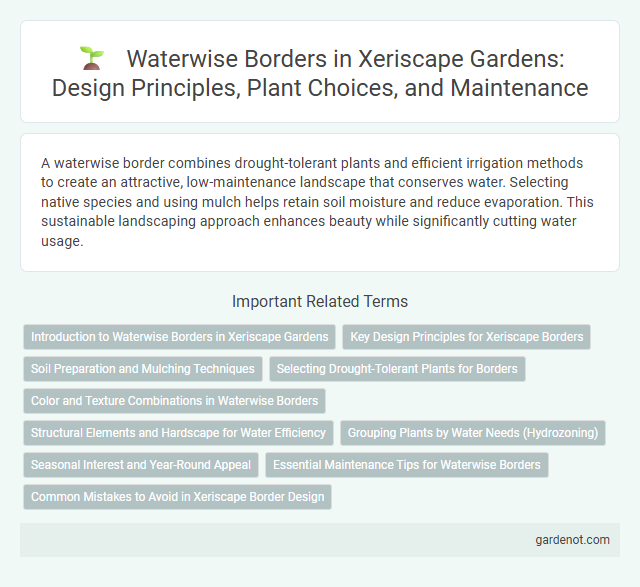A waterwise border combines drought-tolerant plants and efficient irrigation methods to create an attractive, low-maintenance landscape that conserves water. Selecting native species and using mulch helps retain soil moisture and reduce evaporation. This sustainable landscaping approach enhances beauty while significantly cutting water usage.
Introduction to Waterwise Borders in Xeriscape Gardens
Waterwise borders in xeriscape gardens maximize water efficiency by using drought-tolerant plants strategically placed to minimize irrigation needs. These borders incorporate native and adapted species such as succulents, ornamental grasses, and Mediterranean herbs that thrive in low-water conditions. Implementing permeable mulches and efficient drip irrigation further enhances moisture retention, promoting sustainable and attractive landscaping in arid climates.
Key Design Principles for Xeriscape Borders
Waterwise borders in xeriscaping emphasize drought-tolerant plant selection, ensuring species thrive with minimal irrigation. Strategic layering combines deep-rooted perennials with groundcovers to optimize soil moisture retention and reduce evaporation. Incorporating permeable materials and mulches further conserves water, promoting sustainable and attractive landscape edges.
Soil Preparation and Mulching Techniques
Waterwise borders in xeriscaping rely heavily on proper soil preparation, emphasizing well-draining, nutrient-rich soil mixed with organic compost to retain moisture efficiently. Mulching techniques use organic materials like bark, straw, or wood chips to reduce evaporation, suppress weeds, and stabilize soil temperature. These practices improve water retention and promote healthy plant growth while minimizing irrigation needs.
Selecting Drought-Tolerant Plants for Borders
Selecting drought-tolerant plants such as lavender, yucca, and agave ensures a waterwise border that thrives with minimal irrigation. These species adapt well to xeriscape conditions, reducing water consumption while maintaining vibrant aesthetics. Incorporating native plants like sedum and ornamental grasses further enhances border resilience and sustainability.
Color and Texture Combinations in Waterwise Borders
Waterwise borders in xeriscape gardens thrive by incorporating diverse color and texture combinations that enhance visual interest while conserving water. Utilizing drought-tolerant plants like lavender, sage, and ornamental grasses, which offer contrasting foliage colors and textures, creates dynamic and sustainable garden edges. Strategic placement of succulents and native wildflowers alongside gravel or mulch further amplifies the textural richness, promoting low-maintenance yet vibrant borders.
Structural Elements and Hardscape for Water Efficiency
Waterwise borders in xeriscape design incorporate structural elements such as raised beds, berms, and swales to direct and retain water efficiently, minimizing runoff and promoting deep soil infiltration. Hardscape features including permeable paving, gravel paths, and stone edging enhance water conservation by reducing evaporation and controlling drainage within garden zones. These components work together to create sustainable, low-maintenance landscapes that optimize water use without sacrificing aesthetic appeal.
Grouping Plants by Water Needs (Hydrozoning)
Grouping plants by water needs, known as hydrozoning, is essential for creating an efficient waterwise border in xeriscape landscaping. By clustering drought-tolerant species separately from those requiring more moisture, irrigation can be precisely tailored, significantly reducing water waste. This method supports healthy plant growth while promoting sustainable water conservation in arid environments.
Seasonal Interest and Year-Round Appeal
A waterwise border in xeriscaping combines drought-tolerant plants that offer vibrant seasonal interest through varied textures, colors, and flowering cycles, enhancing visual appeal throughout the year. Incorporating evergreen shrubs, ornamental grasses, and succulents ensures structural beauty during varied seasons, maintaining garden vitality even in dry periods. Selecting native species adapted to local climates promotes sustainable growth while delivering consistent year-round aesthetic value.
Essential Maintenance Tips for Waterwise Borders
Waterwise borders require regular maintenance to ensure plant health and optimal water efficiency, including deep but infrequent watering to encourage deep root growth. Mulching with organic materials helps retain soil moisture and suppress weeds, reducing water loss and competition for resources. Periodic pruning and removal of dead foliage promote air circulation and prevent disease, maintaining the border's aesthetic and sustainability.
Common Mistakes to Avoid in Xeriscape Border Design
Overloading xeriscape waterwise borders with high-water-demand plants is a common mistake that undermines water conservation efforts. Poor soil preparation, such as failing to improve drainage or amend soil with organic matter, leads to plant stress and inefficient water use. Neglecting to group plants with similar water needs disrupts irrigation efficiency and increases water waste in xeriscaping.
Waterwise border Infographic

 gardenot.com
gardenot.com